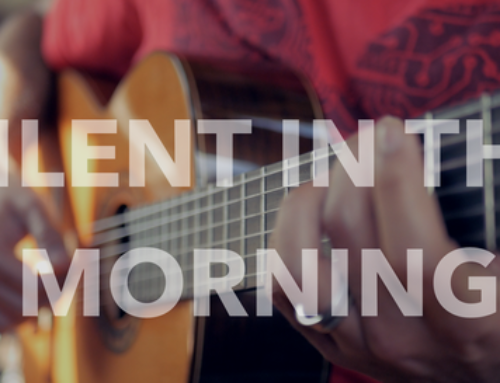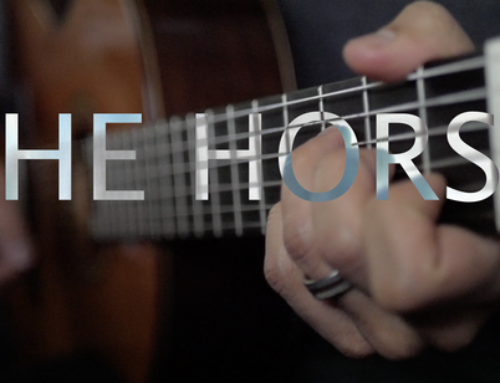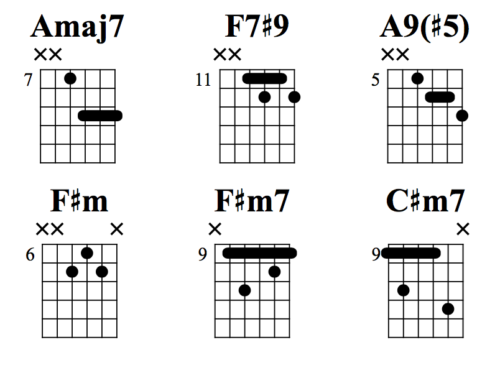In this lesson we’ll take both of Jerry Garcia’s solos on “Me & My Uncle” from 4-24-1978 with the Grateful Dead, and break them down into 13 different licks. You’ll learn why this solo sounds as good as it does, and more importantly, you’ll learn how you can use these ideas in your own solos!

As a quick note, some people play a G chord after the A chords in bars 15 & 16. If you listen to the recordings, you can hear that the band is playing an Em chord in bar 17.
Let's get started with learning Jerry Garcia's back-to-back solos from Me & My Uncle from 4-24-1978 with the Grateful Dead.
Lick 1
This is a pedal steel-style lick that is based on the E minor pentatonic scale. Notice that the bend on the G string from the 14th to the 16th fret is plucked and held. Then Jerry picks the 15th and 12th fret on the B string, and then releases the G string when he bends down from the 16th to the 14th fret.
What makes this lick even more interesting is that Jerry mimics Bobby’s vocals in a very subtle way. The rhythmic figure in this lick is very similar to the vocal cadence on lines like “just about halfway” in verse 1, or “ordered drinks for all” in verse 2, or “he starts playing the game” in verse 3.
Lick 2

Over the G chord, Jerry is playing the G major pentatonic. Over the E minor chord, he plays the E blues scale.
The G major pentatonic has the same notes as the E minor pentatonic. Thee G major blues scale has the same notes as the E minor blues scale.
Let’s take a look at the G major blues scale and the E minor blues scales from the 9th to the 15th fret:


Since these scales have the same notes, it is the context (the background chords) that lets us know what scale we are actually playing.
Truthfully, nitpicking the names of scales isn’t really that important in the long run. But we nerds obsess over the littlest of things, don’t we?
Lick 3

Yet again, we have another set of licks based on the E minor and G major blues scales.
During the first part of the lick, Jerry gives you the D by landing on the 10th fret of the E string on beat 1 of the G chord. Of course, the D is the 5th of G and yields a strong, stable sound.
Jerry snakes around the blues scales for a few beats, and comes home strong. During the second part of the lick, he lands on the root for beat 1 of the E minor chord. The root being the most stable of all chord tones in our deck.
Towards the end of this lick, we also see our first note that is outside of the G major / E minor blues scales. Jerry plays the D# on the 13th fret of the D string, which a half step below the E root. This acts as a subtle bit of tension that leads back to the E minor root, which is the E note on the 14th fret of the D string.
Lick 4

Up until now, Garcia has hit basic chord tones on beat 1 of each new chord. This lick is different, because he hits the Bb on beat 1 of the G chord. Bb is the b3 of G, which gives us a nice bit of of tension since Bb is not in the key of G major.
After some quick-fire major blues scale work, he connects the 5th of G (D note, 12th fret D string) to the 3rd of A7 (C# note, 11th fret D string). Although this is subtle, it’s the cumulation of these single note voice-leading approaches that have cemented Jerry as one of the most melodically gifted soloists in rock history.
Often, non-jazz guitarists completely disregard this notion of connecting one chord tone to another, but we can see how important and easy it can be.
At the end of this lick, Jerry emphasizes the root, 5th and b7th of the A7 chord. This gives us a nice bit of stability after the longer lick that preceded it.
Lick 5

In this phrase, Jerry mixes a standard E minor country guitar lick with some bluesy bends over the B7 chord. Although there’s only a few notes here, its one of the deceptively hardest licks in the solo because of the speed and precision involved in the 14th to 15th fret bends on the G string.
Lick 6

This one starts off in E minor with Jerry bending the b7 (D note, 15th fret B string) to the root (E note, 17th fret B string) and back down again to the b7. Then a quick pluck of the fifth (B note, 12th fret B string), pre-bend from the fifth (B note, 16th fret G string) to the eleventh (A, 14th fret G string). He then finishes off this lick by doing a quick riff centered around the E minor pentatonic.
Congratulations, you’ve made it to the end of the first solo!
Lick 7

To start off the second solo, Jerry starts with a relatively slow bend from the fifth of G (D, 15th fret B string) to the sixth (E note, 17th fret B string) and back down again to the fifth. He quickly plays the eleventh (C note, 13th fret B string) making it seem like he’s going to descend down a scale or arpeggio.
However, the crowd goes nuts and he changes direction by going up the G major pentatonic scale. Jerry then plays a simple, yet effective, phrase out of the E minor blues scale over the E minor chord.
Lick 8

This lick is more rhythmically sophisticated than the others that we have played so far. Jerry plays a three note repeating figure over the G chord, and then smoothly transitions into a blues lick based on the E minor blues scale, over the E minor chord.
The biggest challenge for this lick may be the switching of positions. For the G chord, we are in 15th position, and we slide down to 12th position. At performance tempo (220 bpm!) this can get tough, so make sure you can play it smoothly at slower tempos before you tackle it at full speed.
As mentioned during other licks in the video, notes in (parentheses) are ghost notes that Jerry picks so softly, you can just barely hear them.
Lick 9

This phrase is similar to Lick 4, because Jerry starts with the b3 of G (Bb, 11th fret B string) on beat 1 of the G chord. This, again, adds a bit of tension compared to the other licks of this solo where he starts with a chord tone of G.
He then trickles down the G major blues scale, building excitement with some rhythmic tension by using a rapid fire eighth note pattern.
Lick 10

Yet again we have the E minor blues scale being played over the E minor chord. As a quick disclaimer, the second note of this lick involves a half step below the root (D# note, 13th fret D string) which is outside of our scale.
Jerry continues with some more rapid fire notes, ultimately landing on the fifth of our G chord (D note, 10th fret E string), giving some stability (resolution) after applying some rhythmic and scalar tension during this lick.
Lick 11

This lick starts off with a slide based on the G major pentatonic scale. But then we have some efficient single note voice leading, where he connects the 3rd of G (B note, 14th fret) to the root of the A7 chord (A note, 12th fret A string).
Señor Garcia makes an interesting stylistic choice over the A7 chord. If you listen to the recording, the band is getting louder and more intense, and mister lead guitarist extraordinaire could have made the decision to play a ton of notes. But instead of doing that, he opts for a more stripped down rhythmic approach by playing the root of A7 in two octaves.
He's always full of surprises!
Lick 12

Here we have another Em blues lick, played soulfully and sweetly in 12th position. This lick is a slight variation of lick 5, and both of these happen in a similar place towards the end of the chord progression.
Lick 13

To finish off the second solo, we’ve got a chicken pickin’-style lick over the Em chord. The first note is the b3rd of Em (G note, 12th fret G string) and Jerry does a slight upwards bend on it. To maximize the B’gock factor make sure that you treat it like a 1/4 step bend, not a 1/2 step bend.
For the B7 to Em finale, Jerry starts on the root of the B7 chord (B note, 14th fret of A string) and traverses down the Em blues scale until he lands on the root of the Em chord (E note, 12th fret of the low E string).
If you enjoyed this lesson, please leave a comment and share this article with a guitar buddy and/or deadhead that would enjoy it!
Gear Used for This Video
Performance:
- Custom 50th Anniversary Tiger Guitar by Lieber Guitars
- Custom Ceriatone 100W FM Amplifier w/ Modern Eagle Mod & C-lator by Ceriatone
- Custom Diagonal 2 x 12 Cabinet by Avatar
- 2 x Eminence Patriot Swamp Thang 12″ Speakers
- Pickboy Pos-a-Grip Jazz Classic Tortoise Shell Cellulose 1.50mm Picks
- Planet Waves Custom Series Right Angle Guitar Cable
Recording:
- Shure SM57-LC Cardioid Dynamic Microphone (vocal mic)













Thank you so much. That lesson was SO SWEET!!
Do you have other lessons on Garcia’s solos, if so where do i find them?
THANKS AGAIN